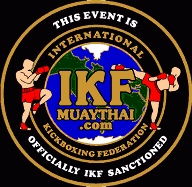 IKF
IKF
MUAY THAI
RULES
- MTR -
Please
see GENERAL BOUT RULES
PAGE
In ADDITION to the rules below. - Click
HERE
HOME -
NEWS -
EVENTS
- RANKINGS
- SANCTIONING
- JOINING -
RULES & REGULATIONS
-
MERCHANDISE
- ISCF MMA

THE HISTORY OF IKF MUAY
THAI
ONE OF THE FIRST TO SANCTION AND REGULATE IT HERE IN THE USA
CLICK
HERE
MUAY THAI
RULES
DETAIL
SINGLE BOUT
AMATEUR
EVENTS
MULTI FIGHT
TOURNAMENT
EVENTS
PRO BOUTS
KICKS
ABOVE WAIST
ALLOWED
ALLOWED
ALLOWED
KICKS
TO THE LEGS
ALLOWED
ALLOWED
ALLOWED
KICK
MINIMUM
NO
NO
NO
KNEES
SEE BOTTOM OF PAGE FOR FULL DETAILS
- All Knee Targets shall be determined during event matchmaking with each
fighter of each fight and the event matchmaker.
Please CONFIRM with the Event Matchmaker & The IKF Event Representative what will be ALLOWED in your bout.- REGULAR EVENTS
- In FULL Muay Thai, knees ARE ALLOWED to the Head, the Body and Legs.
- MODIFIED MUAY THAI (Limited Knee Targets): Click
HERE
- AMATEUR TOURNAMENT COMPETITION
- Please refer to Tournament Rules for each Tournament. Some (IKF World
Classic) only allow knees to the body and legs below the shoulder line but
NOT to the Head. While others have an actual FULL Muay Thai rules Division.
- Please refer to Tournament Rules for each Tournament. Some (IKF World
Classic) only allow knees to the body and legs below the shoulder line but
NOT to the Head. While others have an actual FULL Muay Thai rules Division.
- PRO
EVENTS
- Knees are allowed to the Body, Legs and the Head.
- MODIFIED MUAY THAI (Limited Knee Targets): Click
HERE
- REGULAR EVENTS
SWEEPS
Foot To Foot - No Spin Sweeps
SEE BOTTOM OF PAGE FOR FULL DETAILS
ELBOWS
SEE BOTTOM OF PAGE FOR FULL DETAILS
- All Elbow Targets shall be determined during event matchmaking with each
fighter of each fight and the event matchmaker.
Please CONFIRM with the Event Matchmaker & The IKF Event Representative what will be ALLOWED in your bout.- REGULAR AMATEUR EVENTS
- Elbows are allowed to the legs, body and the *Head.
- (*) Must wear Elbow Pads.
- When Elbow Strikes are allowed to the head, IKF Approved or Endorsed Elbow Pads are MANDATORY. Otherwise, bouts with elbow strikes to the body ONLY do not require elbow pads. Strikes with elbows and knees are allowed. However, some State Athletic Commissions may not allow knees to the head or elbows at all. Under these circumstances, these Muay Thai Bouts will be called "MODIFIED MUAY THAI". To be a Muay Thai bout at all, there must be at least Knee Strikes to the body. Please CONFIRM with the event Matchmaker what will be ALLOWED in your bout. Knees to the Head, Elbows, etc.
- "STRAIGHT 12-6" Dropping or Spiking Downward Elbows (Where the fist is ABOVE the Elbow on Impact) are Illegal and NOT ALLOWED!
- No strikes are allowed to the Groin, Knees or Spine.
- Elbows are allowed to the legs, body and the *Head.
- AMATEUR TOURNAMENT
COMPETITION
- Please refer to Tournament Rules for each Tournament.
- Some States only allow elbows to the body, below the shoulder line but NOT to the Head.
- Some States, such as Florida do not allow Elbows at all.
- While others have an actual FULL Muay Thai rules Division.
- PRO
MUAY THAI
- FULL MUAY THAI: Elbows are allowed to the Body, Legs and Head.
- MODIFIED MUAY THAI: Allows for the option of various technique "TARGETS".
- Elbows to the Body & Legs Only.
- Knees to the Body & Legs Only.
- Knees to the body, head and legs but Elbows to the Body & Legs Only.
- Rules may adapt in many different ways such as K-1 Known as IKF Unified Rules.
- REGULAR AMATEUR EVENTS
SPINNING
BACKHAND
ALLOWED
NOT IN UNITED KINGDOM
ALLOWED
NOT IN UNITED KINGDOM
ALLOWED
NOT IN UNITED KINGDOM
SPINNING
ELBOW
ALLOWED
NOT IN UNITED KINGDOM
NOT ALLOWED
ALLOWED
SHORTS
MANDATORY
MANDATORY
MANDATORY
PANTS
NOT ALLOWED
NOT ALLOWED
NOT ALLOWED
SHIRTS
NOT ALLOWED
NOT ALLOWED
NOT ALLOWED
HEADGEAR
NO
SHIN PADS
SEE BOTTOM OF PAGE
FOR FULL DETAILS
NO
MOUTH GUARD
MANDATORY
MANDATORY
MANDATORY
MEN: GROIN CUP
MANDATORY
MANDATORY
MANDATORY
WOMEN
PELVIC PROTECTOR
MANDATORY
MANDATORY
MANDATORY
ELBOW PADS
SEE BOTTOM OF PAGE
FOR FULL DETAILS
NO
MANDATORY
MANDATORY
MANDATORY
GLOVES
8 & 12 Ounce Gloves Allowed.
See
Weight
Classes For Sizes.
MANDATORY
Provided by Event Promoters
MANDATORY
Provided by Event Promoters
MANDATORY
Provided by Event Promoters
FOOT PADS
NO
No "SHOES"
Are Allowed
NO
No "SHOES"
Are Allowed
NO
No "SHOES"
Are Allowed
HOME -
NEWS -
EVENTS
- RANKINGS
- SANCTIONING
- JOINING -
RULES & REGULATIONS
-
MERCHANDISE
- ISCF MMA
- IAB BOXING

THE HISTORY OF IKF MUAY
THAI
ONE OF THE FIRST TO SANCTION AND REGULATE IT HERE IN THE USA
CLICK
HERE
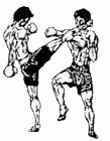
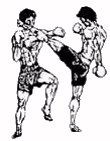
MUAY THAI RULES
- IKF
MUAY THAI RULES
- SHORTS
- If Fighting in a MUAY THAI bout:
- IT IS MANDATORY for you to WEAR "MUAY
THAI SHORTS"
- No MMA Shorts! No Boxing Shorts! No Swim Shorts, etc. etc.
- IT IS MANDATORY for you to WEAR "MUAY
THAI SHORTS"
- SHORTS cannot extend lower than 3 inches from the TOP of the knee.
- If Fighting in a MUAY THAI bout:
- SHIN PADS
- FOR FIGHTERS WITH 2 OR LESS BOUTS.
- SEE AT RIGHT OR CLICK HERE.
- TO ORDER THESE SHIN / INSTEP PADS CLICK HERE.
- IKF Approved Shin / Instep Pads ARE MANDATORY for fighter's with 2 bouts or less.
- IKF Approved Shin / Instep Pads ARE MANDATORY for ALL Fighter's UNDER THE AGE OF 18.
- If there is an athlete with three or less bouts VS another with four or over both must wear IKF Approved Shin / Instep Pads.
- TO SEE A NON APPROVED SHIN / INSTEP PADS CLICK HERE.
- QUALIFIED FIGHTERS WITH 3 OR MORE FIGHTS:
- ADULTS OVER 18 YEARS OLD: Shin / Instep Pads are NOT MANDATORY
for fighter's fighting in their
"4th" MUAY THAI RULES Bout or More. - HOWEVER: To be approved not
to be required to wear them, you must prove your bout History
"A MINIMUM 7 DAYS PRIOR TO YOUR SCHEDULED BOUT" by submitting a BOUT HISTORY FORM. - PAST BOUT
HISTORY FORM - CLICK HERE.
- ADULTS OVER 18 YEARS OLD: Shin / Instep Pads are NOT MANDATORY
for fighter's fighting in their
- MIXED DECISIONS - DECIDED IN MATCHMAKING
- If one "ADULT" fighter chooses to wear Shin / Instep Pads both must wear Shin / Instep Pads.
- If one "ADULT" fighter with more than 3 bouts chooses to wear Headgear both must wear Headgear.
- FOR FIGHTERS WITH 2 OR LESS BOUTS.
- MUAY THAI ACCESSORIES
- Arm Bands (Pra Jiad)
- Defined
- Arm bands (Pra Jiad) may be worn by fighters.
- However, they cannot "Hang-Reach" down past the elbow.
- If the bands slip down, you will be asked to take them off.
- Ankle Wraps/Supports: Fighters may wear athletic style ankle supports.
- Arm Bands (Pra Jiad)
- Defined
- WAI KHRU RAM MUAY
- Wai Khre
- Allowed
- Defined in this context as the *1 Time walk around the ring - Sealing the Ring.
- (*) In performing a FULL Wai Khru Ram Muay, The fighter performs the Wai Khru by circling the ring three times before kneeling and bowing three times as a sign of respect to God and man.
- Wai Khru Ram Muay:
- Allowed IF Promoter has confirmed there is enough time AND has coordinated
with the event DJ to play the appropriate music.
- The fighter performs the Wai Khru by circling the ring three times before kneeling and bowing three times as a sign of respect to God and man.
- He also bows to Buddha (traditionally) to ask for protection for himself and his opponent and for an honorable fight.
- The fighter then performs the Ram Muay, whose simple movements demonstrate a fighter's control and style.
- Each fighter has the option to performs the Ram Muay on each side of the ring to demonstrate his/her prowess to the audience.
- The Ram Muay is a personal ritual, ranging from the very complex to the very simple, and often contains clues about who trained the fighter and where the fighter is from.
- The practitioner may wear a headband called a Mongkhon and armbands known as Pra Jiad during the ceremony, and the Ram Muay may be accompanied by music.
- The Mongkhon is unique to Thai boxing and not be worn in Cambodia or Burma.
- Allowed IF Promoter has confirmed there is enough time AND has coordinated
with the event DJ to play the appropriate music.
- Wai Khre
- THAI MUSIC
- Allowed During the fight.
- IF Promoter has coordinated with the event DJ to play the correct music.
- Music is an integral part of Muay Thai.
- Allowed During the fight.
- KICKS & STRIKES
- KNEES
- SOME STATES DO NOT ALLOW KNEES - CHECK WITH YOUR
LOCAL STATE COMMISSION.
- Knees may not be Allowed in a Modified Muay Thai Rules bout since the term "MODIFIED" indicates something has been taken away.
- Knees are Only Allowed Below the Shoulder Line - Body and Legs. (No
Groin of course)
- No strikes are allowed to the groin or joints -Knees- of the leg.
- No strikes are allowed to the groin or joints -Knees- of the leg.
- SOME STATES DO NOT ALLOW KNEES - CHECK WITH YOUR
LOCAL STATE COMMISSION.
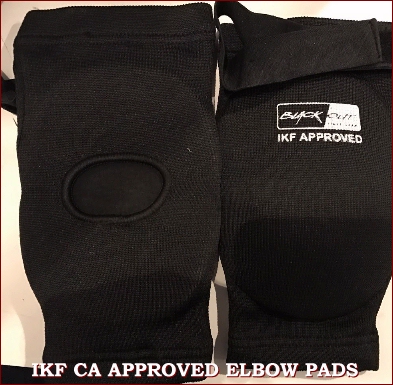 ELBOWS
ELBOWS
- SOME STATES DO NOT ALLOW ELBOWS - CHECK WITH
YOUR LOCAL STATE COMMISSION.
- ELBOWS may not be Allowed in a Modified Muay Thai Rules bout since the term "MODIFIED" indicates something has been taken away.
- Fighters must supply their own IKF APPROVED ELBOW PADS - CLICK HERE OR See Right.
- Since Headgear protects the beginning novice ADULT fighters and ALL
Amateurs wear Elbow Pads, ALL ADULT FIGHTERS 18 years old and older regardless
of fight record are allowed to use elbows.
- NOVICE / BEGINNING ADULT AMATEUR FIGHTERS WITH
UNDER 2 BOUTS:
- NO SPINNING ELBOWS FOR FIGHTERS WITH 2 BOUTS OR
LESS.
- NO SPINNING ELBOWS FOR FIGHTERS WITH 2 BOUTS OR
LESS.
- ALL ADULT AMATEUR FIGHTERS MAY USE ELBOW STRIKES
- Striking Surface is the FOREARM / BACK OF BICEP ONLY! NOT THE POINT OF THE ELBOW!
- PADDED Elbows Allowed to the Body & Head.
- "SPINNING" ELBOWS Allowed to the Body & Head.
- ELBOW TECHNIQUES NOT ALLOWED
- ANY ELBOW STRIKES THAT MAKES CONTACT WITH THE "POINT' OF THE ELBOW.
- NO SPIKING ELBOWS
- NO SPIKING ELBOWS (12 - 6)
- Dropping Elbows.
- Spiking Elbows.
- Downward Elbows.
- 12-6, 3-9 Elbows, Etc.
- Rising Elbows.
- NOVICE / BEGINNING ADULT AMATEUR FIGHTERS WITH
UNDER 2 BOUTS:
- SOME STATES DO NOT ALLOW ELBOWS - CHECK WITH
YOUR LOCAL STATE COMMISSION.
- SPINNING BACKFIST
- Spinning backhands/fists are Legal as long as you strike with the BACK of
your glove, above the wrist line..
- Spinning backhands/fists are Legal as long as you strike with the BACK of
your glove, above the wrist line..
- KICKS
- All standard martial art / Kickboxing Kicks are Allowed.
- You can NOT use The Cartwheel Kick.
- Cartwheel Kick is illegal because your gloves can not touch the ground
before you strike because when they do, you are con sidered a DOWN FIGHTER.
- Cartwheel Kick is illegal because your gloves can not touch the ground
before you strike because when they do, you are con sidered a DOWN FIGHTER.
- DIRECT SIDE / THRUST KICKS
- Direct (Side Kick or Thrust Kick Style) kicks to the front of a fighters legs (Mainly 6 inches above to 6 inches below the knee) are NOT ALLOWED.
- KNEES
- FLASH KNOCKDOWNS
- Flash Knockdown Rule is in effect for all bouts.
- In TRUE Muay Thai as with these rules, FLASH KNOCKDOWNS, where the knocked down fighter rises up immediately after being knocked down are usually not counted as knockdowns with a standing 8 count.
- HOWEVER, if the fighter is "ROCKED" by the shot taken, the
referee can make the decision to give an 8 count if he/she feels necessary, no
matter how fast the fighter rises after the fall.
- CLINCHING
- Clinching is only allowed when opponents are FACING EACH OTHER.
- Clinching is allowed as long as 1 fighter is ACTIVE WITHIN the clinch.
- If there is inactivity for a period of 3 seconds, the referee will break the fighters.
- Fighters may NOT grab an opponent from behind and lift to throw.
- Clinching is only allowed when opponents are FACING EACH OTHER.
- BACK BREAKING
- You can NOT Grab (Clinching) around your opponent's lower spine and
hyper-extending their back (Pulling)
in a "back breaking" move forcing your opponents body to bend backwards hyper-extending their back.
- You can NOT Grab (Clinching) around your opponent's lower spine and
hyper-extending their back (Pulling)
- THROWS - TRIPS - SWEEPS
- Taking an opponent around the waist with both arms and twisting them off
balance so they will fall is legal.
- NO HIP THROWS
- Over the hip throws such as in Japanese arts like Judo, Jutitsu, Karate,
Sambo, or San Shou are ILLEGAL!
- TO DESCRIBE:
- You can NOT use the hip or shoulder to throw an opponent in any kind of judo throw or reap.
- You can NOT step across, or in front of, your opponents leg with your leg and bringing your opponent over your hip.
- You can NOT grab the opponent's hip in a waist lock and throw them using a hip throw
- You can NOT grab an opponent's arm, turning and using the calf and back of the thigh (hamstring muscle group) to sweep an opponent's legs from under them
- You can NOT grab an opponent and fall backward to throw your opponent.
- You can NOT perform a rugby style tackle on the legs and waist of an opponent to throw them.
- You can NOT grab an opponent's waist from behind, then and place a leg between the opponent's legs, pulling the opponent backwards over the leg and hip.
- You can NOT grab an opponent from below the waist and lift them up and
throw them.
- TO DESCRIBE:
- Over the hip throws such as in Japanese arts like Judo, Jutitsu, Karate,
Sambo, or San Shou are ILLEGAL!
- THROWING & SWEEPING
- Fighter may "KICK" (roundhouse or using the top of the foot as well as the instep / arch side portion of the foot) their opponents legs out.
- You can not hook kick with the back of your foot.
- You can not lock an opponent's neck (Like a Headlock) and executing a hip throw.
- You can not grab an opponent in the clinch and then sweep their legs out.
- You can not catch an opponent's leg and using the calf to trip/sweep them off their feet
- You can not trip your opponent with your ankle.
- You can not leg sweep or kick the back of the supporting leg out of your opponent using your calf or inside of your foot.
- You can not trap your opponent's arms in a waist lock and lift them to
throw
- ILLEGAL TRIP
- If you position your foot next to your opponent and twist them over your foot you must clear the leg as your opponent falls or it is an illegal trip.
- An athlete CAN spin or pull an opponent over the inside or outside of the leg and dump him on the ground.
- However the leg being used to manipulate and dump the opponent to the ground can NOT stay in that position as the opponent goes to the floor.
- If it is set and stays in that position, that too is an illegal throw (tripping). In other words, the leg must clear immediately after the opponent is pulled or tripped over the knee.
- Clear means that the leg must be moved out of the way BEFORE the opponent hits the canvas.
- This means skipping the leg or slightly jumping to the side (as long as it is moved from the original position).
- Strangely, this means an athlete can trip over a leg but must move the
tripping leg while the opponent falls to the ground, or it will be deemed
illegal and called a trip.
- NECK WRESTLING
- If in a clinch (locking an opponent's neck) with arms around each others shoulder, as to deliver or defend from an elbow strike, twisting the opponent using the upper body in such a way that you will fall to the ground is allowed.
- If in a clinch (locking an opponent's neck) you may NOT execute a hip to shoulder or hip throw.
- By using neck and shoulder manipulation, you can spin and throw/dump an
opponent to the canvas without using any part of your body as a barrier. This is
fully legal.
- LIFTING
- You can NOT in any way lift an opponent off of the ground to throw them.
- Common to see an athlete clinch their opponent around the waist, lift their opponent off the canvas and then twist and throw them around to the side and onto the canvas.
- This is illegal and points could be deducted of continues use this move.
- Taking an opponent around the waist with both arms and twisting them off
balance so they will fall is legal.
- PLOWING
- Fighters are allowed to catch their opponents leg and take 2 steps forward.
- You can "dump" a person if you catch their leg and throw it back towards them causing them to fall backwards but must do so within 2 steps (see previous).
- You can also catch under their knee while they are doing a swing knee and topple them over backwards but must do so within 2 steps (see previous).
- AFTER TWO STEPS
- The fighter holding the leg must STRIKE before taking a third step or more or let go!
- You can not hold a leg and charge/push an opponent to the ropes.
- You can not catch an opponent's leg and use your other arm to push them off
balance while taking more than two steps forward.
- LANDING
- Stepping on a fallen opponent is illegal. Commonly one sees an athlete twist and pull an opponent over the side of their body (and then land on top), this is illegal.
- It is considered an Intentional foul is when a fighter plans, with the sole
intention, of falling on top of their opponent to either strike with their knee
or to intentionally hurt their opponent, by making it look like an accident.
- SHORTS
- "FULL" MUAY THAI RULES
ADULTS OVER 18 YEARS OLD ONLY.
- MUAY THAI RULES
- See Above.
- See Above.
- A Fighter fighting in their "4th" Bout or More.
- Must have a MINIMUM of 3 fights.
- Must have a MINIMUM of 3 fights.
- FIGHTER MUST SUBMIT A PROOF OF PAST HISTORY / EXPERIENCE FORM TO CONFIRM RECORD
- HEADGEAR
- Not Required.
- Not Required.
- SHIN PADS
- Not Required.
- Not Required.
- ELBOWS & ELBOW PADS
- See Above.
- MUAY THAI RULES
PRO
MUAY THAI
GENERAL RULES
- No strikes are allowed to the groin or joints of the leg.
- Elbow Strikes are allowed but OPTIONAL in IKF
PRO Muay Thai Bouts.
- HOWEVER, Elbow Strikes to the head but MUST BE CONFIRMED IN MATCHMAKING with BOTH Fighters.
- Please CONFIRM with the event Matchmaker what will be ALLOWED in your bout.
- Fighters may strike with Punches, Kicks, Knees and SOMETIMES ELBOWS;
- Strikes with elbows and knees are allowed. However, some State Athletic Commissions may not allow knees to the head or elbows at all. Under these circumstances, these Muay Thai Bouts will be called "MODIFIED MUAY THAI". To be a Muay Thai bout at all, there must be at least Knee and Elbow Strikes to the body. Please CONFIRM with the event Matchmaker what will be ALLOWED in your bout, Knees to the Head, Elbows, etc.
- KICKS (Shin or Foot) & KNEES are allowed to BOTH legs (Not the Knees) of each fighter.
- KICKS may strike body and head as well.
- KNEES may strike to the legs, body and head.
- Clinching is allowed as long as 1 fighter is ACTIVE WITHIN the clinch.
- MUAY THAI Throws are Allowed. NOT HIP THROWS.
- Fighters are allowed to catch their opponents leg and take 1 step forward.
After 1 step, the fighter holding the leg must STRIKE before taking a second
step or more.
- Sweeps (With instep of foot) are not allowed but a fighter
may "KICK" his/her opponents supporting leg with the top
of their foot or shin, NOT the instep as in a karate style sweep.
- No strikes are allowed to the groin or joints of the leg.
- In TRUE Muay Thai as with these rules, FLASH KNOCKDOWNS
where the knocked down fighter rises up immediately after being knocked
down are NOT COUNTED AS A KNOCKDOWN OR STANDING 8 COUNT.
- HOWEVER, if the fighter is "ROCKED" by the shot
taken, (Whether he is still standing or drops to the canvas / ring floor)
the referee can make the decision to give an 8 count if he/she feels necessary,
no matter how fast the fighter recovers or rises after the fall.
- HOWEVER, if the fighter is "ROCKED" by the shot
taken, (Whether he is still standing or drops to the canvas / ring floor)
the referee can make the decision to give an 8 count if he/she feels necessary,
no matter how fast the fighter recovers or rises after the fall.
- Direct (Side Kick Style) kicks to the front of a fighters legs Are
NOT ALLOWED.
- Kicks (shin or foot) may strike the inside and outside of each fighters legs.
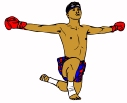
A Brief Lesson In
Muay Thai
101
|
|
As we here at the IKF have always done for our fans of these pages, we always try to educate "EVERYONE" on aspects of our sport and maybe a short class here in Muay Thai 101 will help to form where this article is going. Some of you may know most if not all we will teach in this class while others will answer honestly, "Oh, I didn't know that." So let the class begin… Nearly every weekend around the world there's a kickboxing event that advertises they will feature the long honored fighting art of Thailand known as Muay Thai. If these fighters are both following true MuayThai tradition, they will both enter the ring over the top rope. Why? In MuayThai tradition, the Mongkon (headpiece wore around the top of each fighters head prior to their bout) is blessed for good luck by each fighters respected religion. Going over the top rope is symbolic that God is Above All Things such as the ring ropes. The spectators and their peers see 2 fighters dressed in the traditional Muay Thai shorts with their Mongkon wore proudly on their head. Once in the ring the traditional MuayThai music begins and a fighter has their first options of the bout. However in Thailand, this is NOT an option and SHOULD NOT be an option even in other parts of the world. These options are not fighting options such as "Should I throw a Jab or a knee etc." these options are the ones of long and honored traditions of Muay Thai. To seal the ring (The walk around the ring which symbolizes the sealing of evil spirits from the ring), begin their Wai Kru (Wai means Bow and Kru means Teacher. When the fighter bows down paying homage to their teacher, club and family) and or a Ram Muay. (Which translates into boxer dance) or to simply stand and await for their opponent to be ready and the referee to begin the bout. Keep in mind that not all MuayThai fighters perform these things. Even in Thailand, they are a fighters choice. If a fighter decides to seal the ring we'll see them stopping to pray in each corner. In Thailand, the Wai Khre is paying homage to their Buddha. This pray continues at each corner during their walk to all four corners. Once again, a fighter may now choose to perform a Wai Khre followed by their own version of their Ram Muay. Often during a fighters Ram Muay, many true fans of Muay Thai fighting may not know what the dance is for. To answer this question, the dance expresses a fighters balance and agility. Sometimes at it's end, it may be followed by a show of confidence or challenge towards their opponents corner such as a stomping of their feet or an imitation of shooting an arrow at their opponent. To true fans of the sport, this is all part of the bout as well. As each fighters rituals ends, the trainer removes their Mongkon and turns to face their opponent.
|
|
|
THE HISTORY OF IKF MUAY
THAI | ||
|
HOME - NEWS - EVENTS - RANKINGS - SANCTIONING - JOINING - RULES & REGULATIONS - MERCHANDISE - ISCF MMA - IAB BOXING | ||



